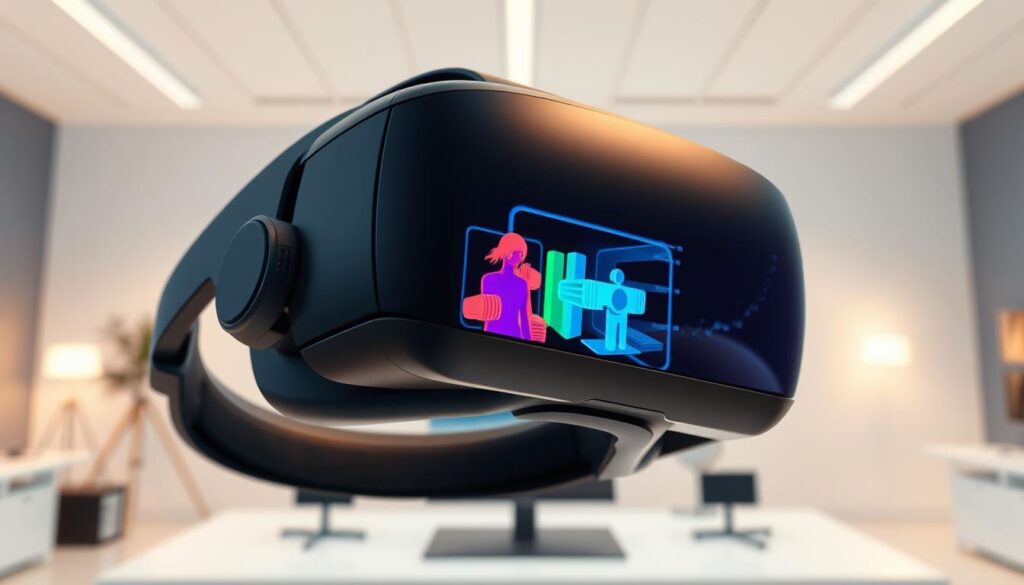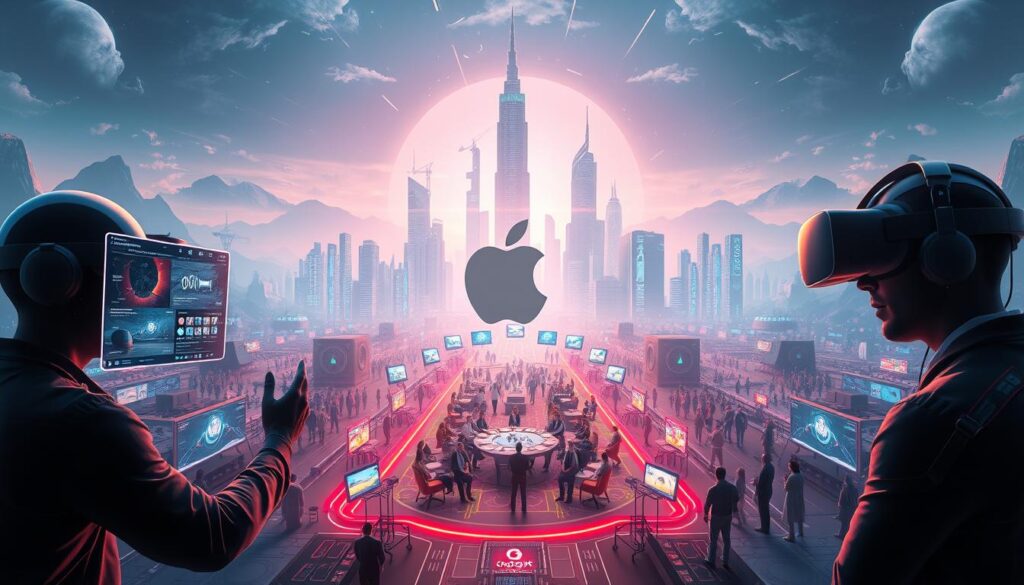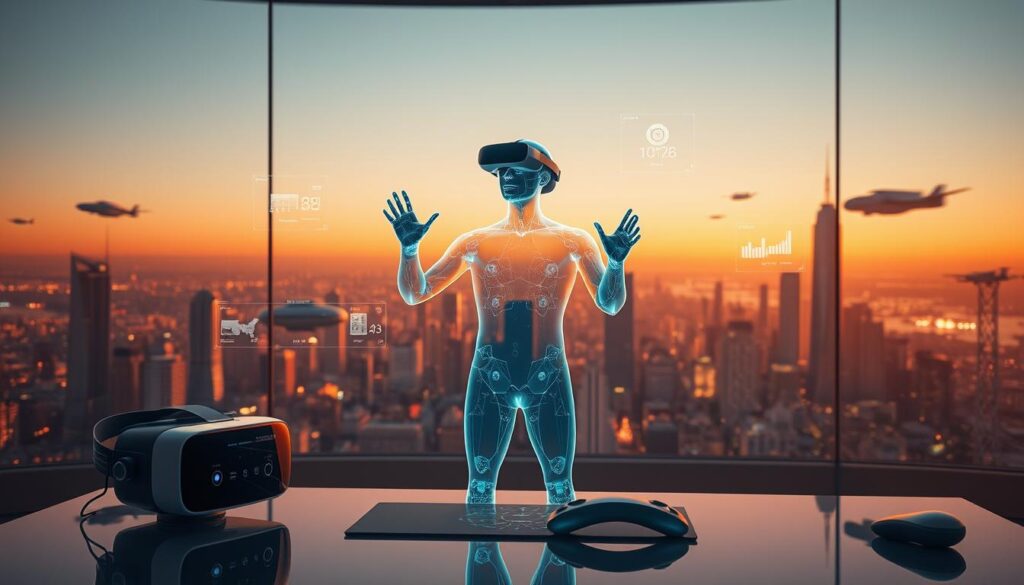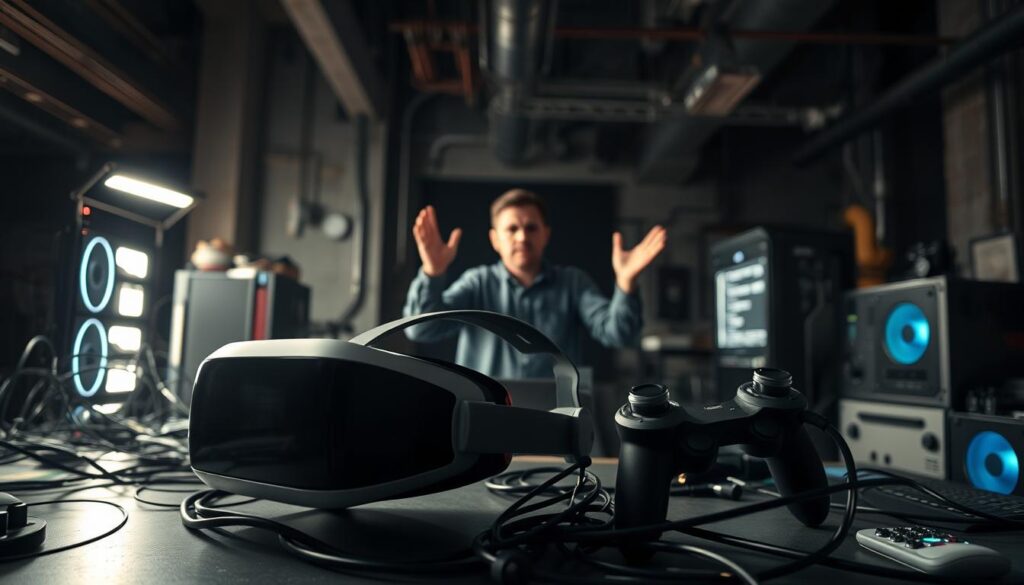
The way we connect digitally is evolving fast. Video calls may soon feel outdated as new immersive experiences emerge. Could advanced tech reshape how businesses and teams collaborate?
Recent breakthroughs suggest a major shift is coming. Sales of smart glasses hint at growing consumer interest in augmented reality. Enterprise solutions already offer secure holographic conferencing.
But challenges remain. Network demands and platform compatibility could slow adoption. Established players won’t disappear overnight. The future likely holds a mix of traditional and next-gen tools.
Key Takeaways
- Immersive tech could transform digital collaboration by 2025
- Smart glasses sales indicate rising consumer interest
- Enterprise solutions now offer encrypted holographic meetings
- Bandwidth needs may impact widespread adoption
- Video conferencing will likely coexist with new formats
The Rise of XR: Redefining Remote Collaboration
Remote work is entering a new era with spatial computing. Flat screens and static feeds are giving way to dynamic, 3D environments. Companies like ARHT Media already cut event costs by 60% using holograms, proving the market potential.
From Zoom Fatigue to Immersive Meetings
Nearly half of professionals report exhaustion from traditional video calls. Static grids and delayed audio strain focus. Extended reality (XR) solves this with:
- Spatial audio: Voices come from their virtual positions.
- Gesture recognition: Natural interactions replace awkward pauses.
- Shared 3D spaces: Teams manipulate objects like whiteboards or prototypes.
Imperial College London’s 2018 holographic lecture, covered by BBC, showed how immersive experiences boost engagement. Students recalled 30% more content versus video.
Why 2025 Could Be the Tipping Point
Three factors align:
| Factor | Current Status | 2025 Projection |
|---|---|---|
| Hardware Cost | $3,000+ (Apple Vision Pro) | ~$1,500 (Meta’s rumored Quest Lite) |
| Network Speed | 5G (1 Gbps) | 6G trials (1 Tbps) |
| Software | Gaming-focused | Productivity suites (Horizon OS) |
COVID-19 accelerated remote work trends. By 2025, 6G networks and affordable glasses could make holographic meetings mainstream. The future isn’t about replacing Zoom—it’s augmenting it.
XR Hardware Evolution: Beyond VR Headsets
Next-gen devices are blurring the lines between physical and digital spaces. Lightweight designs and advanced sensors now enable seamless mixed-reality workflows. Enterprises lead adoption, with 42% of Fortune 500 companies testing spatial computing tools.

Meta Quest 3 and the Shift to Mixed Reality
The Quest 3’s passthrough cameras track real-world interactions with sub-millimeter precision. This product marks a pivot from isolated VR to hybrid workspaces. Enterprises favor its modular upgrades—67% use it for 3D prototyping.
Apple Vision Pro and Google’s Android XR Ecosystem
Apple’s eye-tracking OS contrasts with Google’s open Android XR platform. Project Moohan integrates Gemini AI for real-time language translation. Key difference: Vision Pro prioritizes premium immersion, while Android XR targets affordability.
Holographic Waveguides and Ultra-Thin AR Displays
Waveguide technology enables sunglasses-style AR glasses. Snap’s Spectacles 5 prototype costs $3,200, but consumer targets aim for $500. These displays project 4K visuals directly onto retinal cells.
| Feature | VR Headsets | MR Devices |
|---|---|---|
| Enterprise Adoption | 28% (Training sims) | 61% (Collaboration) |
| Avg. Price | $800 | $1,900 |
| Use Case | Gaming, Simulations | Design, Remote Assist |
The future lies in augmented reality wearables. By 2025, 70% of devices may use waveguides, reducing bulk while enhancing clarity.
Holographic Meetings: Is XR the End of Zoom in 2025?
Digital collaboration is undergoing a radical transformation with lifelike holograms. Companies like ARHT Media are leading the charge, proving that flat screens no longer define connectivity.
ARHT Media’s HoloPod and Live Beaming
ARHT’s HoloPod projects 4K holograms with sub-100ms latency, making remote speakers appear lifelike. Their ETF presentation in Singapore achieved 92% audience retention—far higher than traditional webinars.
Key advantages:
- No glasses needed: Viewers see holograms with naked eyes.
- Encrypted data streams: Vital for sensitive business discussions.
- Hybrid event integration: Live audiences interact with holographic presenters.
Case Studies: Pharma, Education, and Corporate Events
In pharma, holographic conferences cut costs by 40% versus in-person events. A 2023 study showed 70% higher attendee recall for drug trial data presented via holograms.
Universities report similar gains. MIT’s holographic lecture series saw 50% more student participation. *”It’s like having Einstein teach physics in your classroom,”* noted one professor.
Brands like Coca-Cola use holograms for immersive experiences. Their SpatialWeb campaign let users “pour” virtual drinks, blending physical and digital engagement.
| Industry | ROI Boost | Adoption Rate |
|---|---|---|
| Pharma | 40% cost reduction | 35% (2023) |
| Education | 50% engagement rise | 28% |
| Corporate Events | 2x attendee retention | 42% |
The Battle of XR Ecosystems: Meta vs. Apple vs. Google
Tech giants are racing to dominate the spatial computing landscape. Each offers a unique vision for the future of work, from hardware to software ecosystems. The winner could define how millions collaborate.

Meta Horizon OS: Gaming to Productivity
Meta’s Orion prototype showcases neural wristbands for gesture control—a leap beyond controllers. Their product strategy prioritizes enterprise tools, like 3D design suites. Over 60% of Quest 3 users now deploy it for work.
Key advantages:
- Hardware-first: Optimized for seamless mixed-reality workflows.
- Developer incentives: $10M fund for productivity apps.
- Data security: End-to-end encryption for corporate clients.
Apple’s Premium Vision OS Strategy
At $3,499, Vision Pro targets niche markets like architects and surgeons. Its 450+ apps highlight premium immersion, but cost limits mass adoption. *”It’s the iPhone moment for spatial computing,”* claims Tim Cook.
Critical differentiators:
- Retina-grade displays: 4K resolution per eye.
- Closed ecosystem: Tight integration with macOS/iOS.
- B2B monetization: Custom enterprise solutions.
Google’s Open Android XR with Gemini AI
Google’s model emphasizes affordability and AI. Gemini powers real-time translation in 48 languages, crucial for global teams. Android XR’s open-source framework attracts indie developers.
| Factor | Meta | Apple | |
|---|---|---|---|
| Price Range | $500–$1,000 | $3,499+ | $300–$800 |
| Networks | 5G/6G optimized | Wi-Fi 6E | 5G standard |
| Primary Market | Enterprise | Luxury/professional | Consumer/education |
The clash of these ecosystems will shape networks, pricing, and accessibility. While Meta leads in adoption, Apple and Google redefine what’s possible.
Use Cases Accelerating XR Adoption
Industries worldwide are adopting immersive tools to solve practical challenges. From factories to hospitals, these use cases demonstrate tangible benefits that go beyond novelty.
Enterprise: Virtual Product Demos and Training
Manufacturers report 40% faster onboarding with Unity’s XR training sims. Automotive technicians master complex repairs in risk-free virtual environments. The ROI speaks for itself:
- 68% reduction in equipment damage during training
- 53% improvement in procedural recall after 30 days
- 90% cost savings versus physical prototype iterations
Education: Interactive Lectures and Virtual Campus Tours
Stanford’s holographic anatomy lab increased learning retention by 45%. Students manipulate 3D models of human organs with natural gestures. Key advantages over traditional methods:
| Metric | Traditional AV | XR Solution |
|---|---|---|
| Installation Cost | $120,000 | $85,000 |
| Student Engagement | 62% | 89% |
| Content Update Speed | 2-3 weeks | Real-time |
Healthcare: Surgical Simulations and Remote Consultations
Mayo Clinic’s FDA-approved holographic models help surgeons visualize complex procedures. The industry sees remarkable outcomes:
- 28% fewer complications in rehearsed surgeries
- 60% faster diagnosis in rural telemedicine cases
- Real-time vital sign overlays during operations
*”Our residents complete 3x more practice procedures using XR than cadavers,”* notes Dr. Elena Torres of Johns Hopkins.
The Role of AI in Making XR Intuitive
Artificial intelligence is transforming extended reality into seamless experiences. By bridging gaps in interaction and comprehension, AI turns clunky interfaces into natural extensions of human behavior. The result? Tools that feel as intuitive as face-to-face conversations.

Generative AI for Real-Time Translation and Contextual Assistance
Google’s Gemini AI processes visual data three times faster than earlier models. This enables instant translation of speech and text in 48 languages. Latency benchmarks show responses under 200ms—faster than human reaction time.
Enterprise solutions leverage this for secure workflows. Encrypted data flows prevent leaks during cross-border meetings. *”AI doesn’t just translate words; it captures intent,”* notes a Meta engineer.
| Control Method | Accuracy | Adoption Barriers |
|---|---|---|
| Voice Commands | 88% (noisy environments) | Privacy concerns |
| Microgestures | 95% (Meta’s wristband) | Learning curve |
Meta’s Neural Wristband and Microgesture Controls
Meta’s prototype detects subtle finger movements with 95% accuracy. Users scroll or select items by tapping their thumb—no screens required. This technology could replace keyboards in AR workspaces.
Ethical debates persist. Persistent environmental AI raises questions about data ownership. Yet, for users, the benefits are clear: hands-free control and reduced cognitive load.
- Gaze tracking: UI elements expand when looked at, minimizing clicks.
- Contextual menus: AI predicts needed tools based on workflow stage.
- Security layers: Biometric authentication for sensitive actions.
Bandwidth Challenges: Can 6G Enable True Holography?
True holographic experiences require networks we haven’t built yet. Current infrastructure struggles with the data demands of lifelike 3D streaming. The gap between ambition and reality comes down to physics.
Why 5G Falls Short for Holographic Data Rates
5G networks max out at 4K hologram streaming—barely enough for basic projections. Millimeter wave technology delivers 1 Gbps speeds, but holograms need ten times that. Consider these requirements:
- 8K holograms: 50 Gbps per square meter
- Latency: Below 5ms for natural interaction
- Stability: Zero packet loss during critical meetings
Enterprise solutions face particular challenges. Financial firms report 40% higher data needs for encrypted streams. Healthcare applications demand even more bandwidth for precise imaging.
University of Padova’s Research on Terabit Networks
Visible light spectrum experiments achieved 200 Tbps in lab conditions. This waveguide technology could revolutionize future infrastructure. Key breakthroughs include:
| Approach | Speed | Deployment Timeline |
|---|---|---|
| Sub-terahertz 6G | 1 Tbps | 2026-2028 |
| Optical wireless | 200 Tbps | 2030+ |
The impact extends beyond speed. Padova’s prototypes show 90% energy reduction versus current 5G towers. This matters for sustainability as networks expand globally.
LEO satellite constellations offer rural solutions. SpaceX’s Starlink already delivers 300 Mbps—enough for basic holographic calls. However, latency remains above 20ms, creating noticeable delays.
Cost and Accessibility: Barriers to Mass Adoption
Affordability remains the biggest hurdle for widespread holographic adoption. While enterprises pilot $250k ARHT HoloPods, consumers await sub-$500 headsets. The gap reflects divergent business models—and the challenge of scaling immersive tech.

Enterprise vs. Consumer: Two Pricing Worlds
Corporate clients often offset costs through subsidies. Telecom partnerships, like Verizon’s 5G+XR bundle, cut bandwidth costs by 30%. Meanwhile, Meta’s rumored $500 Quest Lite aims for mainstream appeal.
| Segment | Current Avg. Price | 2025 Target |
|---|---|---|
| Enterprise | $250,000+ | $120,000 |
| Consumer | $3,000 | $500 |
AI’s Role in Reducing Content Costs
Generative AI slashes 3D asset creation time by 70%. Tools like NVIDIA Omniverse automate prototyping, making immersive experiences cheaper. *”AI turns $50k productions into $5k projects,”* notes a Unity developer.
- Emerging markets: India’s Jio targets $200 AR glasses with local manufacturing.
- Leapfrog potential: Kenya’s Safaricom tests holographic education via 5G.
- Vision Pro’s BOM: $1,500 build cost vs. $3,499 retail—Apple’s premium markup.
The market will bifurcate: premium products for pros, budget options for classrooms and SMBs. By 2025, economies of scale could rewrite the price playbook entirely.
Spatial Web: The Next Evolution of Virtual Interaction
The internet is transforming into a 3D playground where digital and physical worlds merge. Persistent environments now enable continuous interaction with brand experiences that evolve over time. This shift goes beyond temporary AR filters to create lasting value.
Vatom’s Multimodal Environments and Digital Twins
Vatom’s WebXR platform builds persistent spaces that users revisit across devices. Their NASA Juno campaign achieved 19% interaction rates—triple typical ad engagement. Key features include:
- Ownable digital twins: Users collect and trade virtual objects
- Cross-platform persistence: Progress carries from mobile to VR headsets
- Live event integration: Real-world triggers update virtual content
*”We’re creating the next layer of the internet—one you can walk through,”* explains Vatom CEO Eric Pulier. Pharmaceutical firms now use their tech for persistent product education hubs.
How Brands Like Coca-Cola Are Experimenting
Coca-Cola’s AR can redemption program boosted sales 14% by blending physical purchases with virtual rewards. Their strategy shows three emerging best practices:
| Tactic | Performance | Industry Adoption |
|---|---|---|
| Phygital Events | 2.7x dwell time | Retail: 68% |
| NFT Collectibles | 42% resale value | Luxury: 55% |
| Spatial Ads | 19% CTR | Automotive: 73% |
WebXR adoption varies by sector. While 82% of auto brands test spatial experiences, only 31% of banks do. The gap reflects differing customer expectations in virtual reality environments.
Successful implementations share common traits. They prioritize utility over novelty and design for multi-session engagement. As spatial web standards mature, these experiences will become as commonplace as websites.
Conclusion: Zoom’s Days Aren’t Numbered—Yet
Immersive technology isn’t ready to fully replace video calls. High costs and connectivity hurdles limit widespread adoption. For now, hybrid models blend traditional and next-gen tools.
Enterprises lead the charge, with 40% testing spatial solutions. Smaller businesses lag due to budget constraints. Legacy platforms will likely integrate new features gradually.
The future favors coexistence. Think of it like email and messaging—both thrive despite overlaps. Innovation enhances rather than erases existing workflows.
By 2027, expect smarter hybrid meetings. The impact? Deeper engagement without abandoning familiar tools. Change will come, but not overnight.
